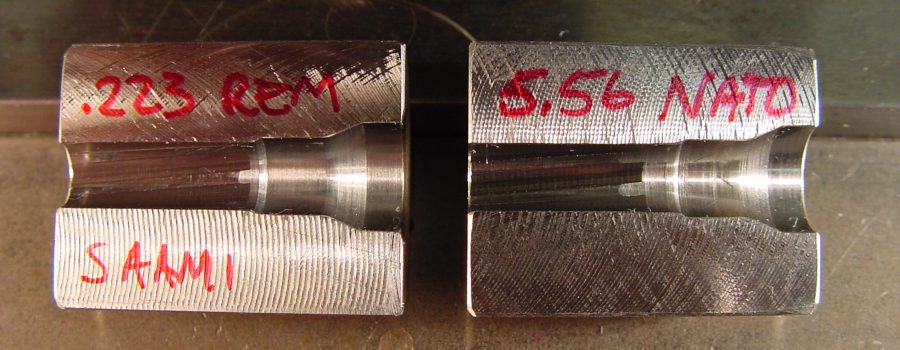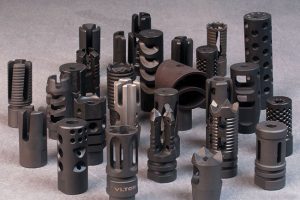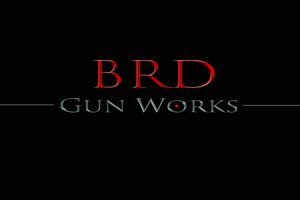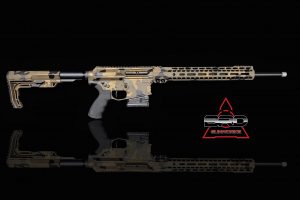On a routine basis I have individuals ask me about the differences of .223 Remington and 5.56 NATO, and which round can be fired in which gun. Then we can step it up to the .223 Wylde chamber that a lot of individuals still don’t know exists, let alone what ammunition they can shoot in it. At times I will field the question of “where can I buy .223 Wylde ammunition” as they haven’t been able to find it in stock anywhere. So let’s take a quick look at .223 Remington vs the 5.56 NATO and dispel some myths and set some facts.
223 -vs- 5.56 Ammunition
Upon inspection of the cases, there are some differences you’ll notice right off the bat between .223 Remington and 5.56 NATO Ammunition:
- On the case rim, you’ll notice “223” stamped on 223 Remington brass, where 5.56 NATO brass may only have a date, initials (Ex: FC) and one or more symbols
- On the case rim, you’ll notice that 5.56 military ammunition will have a crimp around the primer pocket (not the case for new 5.56 cases hand loaded in the civilian market)
There are typically other external differences as well. 5.56 ammunition will have a cannelured and crimped bullet, where 223 Remington ammunition may or may not have a cannelure or crimp. Dimensionally, these cartridges are essentially identical on the exterior with the exception of some bullet profiles used for 5.56 NATO ammunition.
Here are some similarities between .223 Remington and 5.56 NATO Ammunition:
- Same external case dimensions (shoulder transition may have different radius)
- Same cartridge overall length
- Same case trim-to length
- Both cartridges were designed/optimized for 55 grain bullets
- Both use small rifle size primers
Case capacity between the two cartridges is also slightly different:
- 5.56 NATO case capacity: 28.5 grains H2O
- 223 Remington case capacity: 28.8 grains H2O (+1.1% compared to 5.56 NATO)
Pressure Ratings and Testing: Where Confusion Sets In
Where much of the confusion comes when trying to understand the differences between 223 Remington and 5.56 NATO ammunition is when reading the published maximum allowed pressure for each cartridge. What most individuals don’t know is that there are three testing methods and that two of these methods use different locations for testing as well as testing methods.
Methods of testing:
- SAMMI (Sporting Arms and Ammunition Manufacturers’ Institute) pressure testing: requires drilling a hole in case a specified distance back from the case mouth. Pressure is measured externally by means of gas which escapes via hole in case. This method is complicated, but high in accuracy.
- EPVAT (Electronic Pressure Velocity and Action Time) pressure testing: measures pressure from rifle’s chamber/barrel area ahead of location of case mouth. This method is quicker and easier compared with the SAMMI pressure testing method, but is not as accurate.
- SCATP pressure testing: A new military standard for cartridge pressure testing that is essentially equivalent to the SAMMI method.
If we look at the data as previously tested (SAAMI for .223 Remington and the old military testing using EPVAT) we can see that this data would make it appear that 5.56 NATO ammunition is certified “to a higher pressure” than 223 Remington ammunition. That is actually not the case. It’s only when we observe the US Military’s updated pressure testing using the SCATP method and rating data that we will see a parallel with .223 Remington and a 5.56 NATO maximum pressure rating of 55,114 psi.
So if 5.56 NATO and .223 Remington have the same maximum working pressures, what about the “interoperability issues” between 223 Remington and 5.56 NATO then? These is real, some of the time. Let’s first compare the chambers between .223 Remington and 5.56 NATO.
223 Remington and 5.56 NATO Chamber Differences
Chamber dimensions seem to be somewhat “open to interpretation” by reamer manufacturers and firearms OEMs. In short, reamers and chambers will vary, and this is due to how the reamer is made as well as how long a reamer is in service. The longer a reamer is in service the smaller it gets in all dimensions, hence providing for tighter chambers and shorter leades. This is of real concern in 5.56 NATO chambers when it comes to the leade, and is something that I see frequently come across my bench in guns that show signs of excessive pressures such as popped primers, hard extraction, failure to chamber, etc. But the most important thing is how firearms are certified and tested.

The most important difference between the two is the fact that a 5.56 NATO chamber has a leade up to .077” longer, and that the angle into the rifling on a .223 Remington is steeper than the angle of a 5.56 NATO. This 5.56 NATO chamber was designed for the longer bullets, a larger ogive, and for tracer ammunition which is longer than standard 5.56 NATO ammunition.

Let’s look at Forester headspace gauges for both the .223 Remington and 5.56 NATO:
- .223 Remington Go Gauge- 1.4636”
- .223 Remington No Go Gauge- 1.4666”
- .223 Remington Field Gauge- 1.4696”
- 5.56 NATO Minimum Gauge- 1.4636”
- 5.56 NATO Max Gauge- 1.4736”
You’ll notice that the 223 Field (the max safe chamber for 223 Remington, beyond typical chamber dimensions) and the 5.56 NATO “MAX” dimensions are different, with the 5.56 NATO MAX being 0.004″ longer than the 223 Remington FIELD dimension. This is consistent with chamber diagrams.
The biggest problem with these differences is when firing a 5.56 NATO cartridge in a rifle chambered for .223 Remington. Due to the longer leade that the NATO chamber employs this combination will cause a .223 Remington chambered weapon to run at approximately 65,000 psi or more. This is 10,000 psi higher than the .223 Remington’s normal functioning pressure of 55,000 psi. This is NOT safe and will cause primers to back out, or worse, cause harm to the operator, the rifle, or both.
The reverse of this is firing a .223 Remington cartridge in a 5.56 NATO chambered rifle. Due to the leade difference between the two chambers a .223 Remington cartridge may not work optimally in a 5.56 NATO chambered weapon. The cause of this is the lack of pressure built by a .223 Remington cartridge fired from a 5.56 NATO chamber. The .223 Remington’s 55,000 psi will not be attained and therefore velocity and performance are hurt. Problems start occurring when this combination is fired out of a 5.56 NATO chambered rifle with a 14.5” (or shorter) barrel. The lower powder charge of the .223 Remington round coupled with the pressure drop that occurs when it is fired in the 5.56 NATO chamber can cause the rifle to cycle improperly. This is why proper gas port sizes, proper dwell time, gas efficient BCG’s, well-fitting gas blocks and gas tubes are vitally important. Gas issues within the AR platform will only exponentially exacerbate the concern.
Enter the .223 Wylde
Though they share identical case dimensions, the .223 Remington and 5.56 NATO are slightly different—and the .223 Wylde makes the most of both of these loads.
The .223 Wylde has the same chamber angling as the standard 5.56 NATO chamber, so there’s no problem with pressures, and it also has a .2240” freebore diameter. The result? You have a chamber that is sufficient to handle the hotter 5.56 NATO load without concerns about pressure and you get the gilt-edge accuracy that’s common in many quality .223 Remington rifles.
Is there a compelling reason to switch to a .223 Wylde chamber? Well, the most obvious reason is that you can fire .223 Remington ammunition without giving up accuracy and 5.56 NATO ammunition without worrying about excess pressure. Sure, you can fire .223 Remington ammunition all day from a 5.56 NATO without worrying about pressure problems thanks to generous chamber size, but if you really want to tighten those groups that .2240” freebore diameter helps. In fact, .223 Wylde chambers are known for extreme accuracy, which is better on the whole than what you can expect from a standard 5.56 NATO chamber.
A Tidbit on Reloading .223 Remington and 5.56 NATO Ammunition
For those of you who load your own ammunition. Reloading .223 Remington and 5.56 NATO ammunition is essentially the same as loading most other bottleneck rifle cartridges. You will use the same press, powder measure, shellplate or shellholder, and so on and so forth. Reloading dies are the same for .223 Remington and 5.56 NATO because the exterior dimensions are essentially the same. If reloading for an AR I do recommend the use of small base sizing dies as this will provide for more reliable feeding and operation.
When reloading .223 Remington and 5.56 NATO cartridges, there are a few things to keep in mind:
1. If you are loading previously fired military 5.56 cases, you’ll need to swage or ream the primer pockets to remove the crimp.
2. Load data for .223 Remington and 5.56 NATO is NOT the same. Use the appropriate load data for the case you are loading.
3. Check your twist rate! For .223 Remington and 5.56 NATO, twist rates will vary from 1:14 (slow) to 1:7 (fast). Longer/heavier projectiles will require a faster twist rate. Always check the bullet manufacturer’s data to confirm.
4. 22 caliber case mouths are small- I would suggest deburring the interior and exterior of the case mouth with a reamer, as well cleaning the lube from your sized cases before charging with powder to avoid powder sticking/bridging at the case mouth.
Let’s Wrap This Up
Rifles chambered in 5.56 NATO are most versatile and perhaps most reliable. Rifles chambered in .223 Remington can offer enhanced accuracy, but are potentially less reliable in a semi-automatic rifle like the AR-15. Hybrid chambers such as the .223 Wylde attempt to offer the best of both worlds and most will consider it to be a match style chamber. It is safe to shoot .223 Remington cartridges in any 223-variant chamber, but it is not always safe to shoot 5.56 NATO ammunition in a .223 Remington chamber. The perceived differences in pressure rating between .223 Remington and 5.56 NATO are mostly the effect of different pressure testing procedures, and in reality .223 Remington and 5.56 NATO cases are basically equivalent. As with all shooting and reloading: be safe, and always check to make sure your ammunition and rifle “agree”.
I hope that this helps clear up any confusion that you may have had about .223 Remington vs 5.56 NATO.
BRD Gun Works~ Performance you can afford when you can’t afford failure



